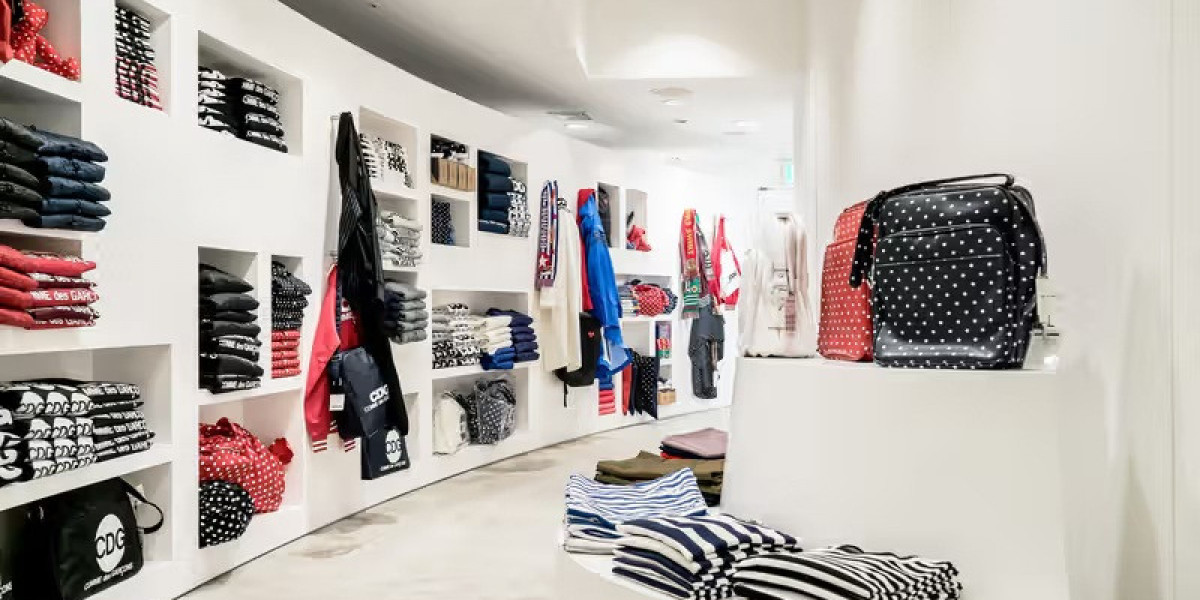Fashion has always been about trends, elegance, and individuality, but few labels have truly redefined what fashion means like Comme des Garçons. Founded in Tokyo in 1969 by the visionary designer Rei Kawakubo, this avant-garde brand is known for its radical concepts, unconventional silhouettes, and its fearless approach to creativity. Over the decades, it has evolved from a small independent label into one of the most influential forces in global fashion.
From its earliest collections to its modern collaborations, Comme des Garçons clothing challenges traditional aesthetics, encouraging wearers to think differently about beauty, gender, and self-expression.
The Origins of Comme des Garçons
The name Comme des Garçons translates from French as “Like Boys,” a fitting reflection of Rei Kawakubo’s mission to blur the lines between masculine and feminine. Before entering fashion, Kawakubo studied fine art and literature—fields that shaped her unique, conceptual design philosophy.
In the early days, Comme des Garcons stood out for its stark, often all-black collections and experimental use of fabric. During the late 1970s and early 1980s, Kawakubo’s work was described as “anti-fashion” because it went against everything mainstream fashion represented. Instead of polished glamour, her pieces were asymmetrical, frayed, and intentionally imperfect.
When Kawakubo presented her first Paris collection in 1981, critics were shocked. Models walked the runway in oversized, torn garments with unfinished hems. Yet, while many dismissed her approach at first, others recognized her as a genius—someone who was breaking fashion down to rebuild it in her own image.
The Design Philosophy of Comme des Garçons
Rei Kawakubo’s work is built around a rejection of conventional beauty. She once said, “For something to be beautiful, it doesn’t have to be pretty.” That idea is at the heart of Comme des Garçons clothing—each piece challenges our perception of what’s attractive or wearable.
Embracing Imperfection
Kawakubo finds beauty in asymmetry, distortion, and the unexpected. Her garments are not designed to flatter the body in a traditional sense; instead, they reshape it. Torn edges, exaggerated shoulders, uneven hems, and layered textiles give her designs a sculptural quality. Each item becomes a piece of wearable art, meant to provoke emotion and thought.
Redefining Gender and Identity
Long before gender-neutral fashion became mainstream, Comme des Garçons was already defying gender norms. Kawakubo’s collections for both men and women shared the same silhouettes and conceptual direction. By removing the boundaries of gendered clothing, she gave wearers the freedom to express identity without societal constraints.
This open-ended design philosophy makes Comme des Garçons clothing not just fashion but a form of communication—one that questions how we define self-image and beauty.
The Evolution of Comme des Garçons
Through the decades, Comme des Garçons has evolved while maintaining its core principles of creativity and innovation.
The 1980s: Disruption and New Identity
In the 1980s, Kawakubo’s work was revolutionary. Her collections, dominated by blacks and greys, symbolized rebellion against the colorful, commercial fashion of the decade. These designs introduced the world to the concept of “deconstruction” in fashion—turning garments inside out, revealing seams, and exposing structure as part of the aesthetic.
Her approach inspired a generation of designers and established Comme des Garçons as a cornerstone of avant-garde design.
The 1990s: Experimentation and Conceptual Art
During the 1990s, Kawakubo became even more experimental. The now-legendary 1997 collection titled Body Meets Dress, Dress Meets Body featured dresses with padded lumps that distorted the body’s natural shape. It wasn’t about beauty; it was about questioning the idea of perfection.
At a time when supermodels dominated fashion, Comme des Garçons clothing was a reminder that fashion could be intellectual and emotional, not just decorative.
The 2000s and Beyond: Collaboration and Expansion
In the new millennium, Kawakubo began exploring collaborations and sub-labels that allowed the brand’s philosophy to reach broader audiences. One of the most popular is Comme des Garcons Shirt, a line that reimagines the everyday shirt with creative cuts, bold patterns, and artistic construction. It bridges the gap between avant-garde design and daily wear.
Around the same period, the brand also collaborated with major global names, leading to iconic creations like CDG Converse—sneakers that combine Converse’s classic silhouette with the playful, instantly recognizable heart logo. These collaborations helped introduce Comme des Garçons to younger generations and established its relevance in both luxury and streetwear culture.
The Comme des Garçons Universe
Over the years, the label expanded into several sub-lines, each representing a different facet of Rei Kawakubo’s imagination.
Comme des Garçons Play introduced casual pieces with minimalist aesthetics, known for the iconic red heart-with-eyes motif created by artist Filip Pagowski. This line’s approachable style made it a favorite among younger fashion lovers.
Comme des Garçons Homme Plus explores experimental menswear, often merging traditional tailoring with futuristic designs.
Meanwhile, CDG Black embraces a darker, monochromatic style, reflecting the brand’s early roots in minimalism and shadowy tones.
Every collection, regardless of the line, shares one thing in common—a deep respect for individuality and artistic freedom. Whether it’s an oversized jacket, a deconstructed dress, or a pair of CDG Converse, each item carries Kawakubo’s spirit of innovation.
Influence on Global Fashion
Comme des Garçons has influenced countless designers and fashion houses across the world. Labels such as Yohji Yamamoto, Maison Margiela, and Vetements have all drawn inspiration from Kawakubo’s fearless experimentation. Her work paved the way for the modern concept of fashion as art rather than mere clothing.
In 2017, the Metropolitan Museum of Art in New York dedicated an exhibition titled Rei Kawakubo/Comme des Garçons: Art of the In-Between. It showcased the designer’s most iconic creations and highlighted her role in reshaping the boundaries between fashion and art.
Comme des Garçons clothing continues to inspire creativity, reminding both designers and consumers that fashion can challenge, provoke, and transform.
A Symbol of Individuality
Wearing Comme des Garçons is not about following trends; it’s about embracing individuality. The brand attracts people who value originality, courage, and expression. Its designs are not made to fit into categories—they are made to stand out.
Celebrities like Rihanna, Pharrell Williams, and Tilda Swinton have been spotted wearing Comme des Garçons clothing, each interpreting the pieces in their own unique way. The brand has also become a cultural symbol for those who see fashion as a form of self-expression rather than conformity.
Through collections like Comme des Garçons Shirt and its collaborations like CDG Converse, the brand has proven that even the most avant-garde ideas can coexist with everyday wear. This balance between art and practicality has helped Comme des Garçons remain relevant in a rapidly changing fashion landscape.
The Connection Between Streetwear and Luxury
One of the most fascinating aspects of Comme des Garçons is its ability to merge high fashion with street culture. What started as an avant-garde art movement now influences sneaker drops, streetwear brands, and youth culture. The partnership with CDG Converse is a prime example of how high-concept design can translate into global, everyday appeal.
By embracing collaboration without compromising its artistic integrity, Comme des Garçons created a bridge between exclusive runway fashion and accessible style. It’s this rare ability to evolve without losing authenticity that has cemented its place in modern fashion history.
Sustainability and Timeless Design
While Comme des Garçons rarely markets itself as a “sustainable brand,” its approach naturally embodies sustainable principles. The label avoids overproduction, focuses on quality craftsmanship, and often reuses materials in creative ways.
More importantly, Comme des Garçons clothing is designed to last—not just physically, but conceptually. A piece from twenty years ago can still feel modern because it was never about following trends in the first place. The timeless nature of Kawakubo’s work encourages conscious consumption and long-term appreciation of design.
The Legacy of Rei Kawakubo
Rei Kawakubo’s influence extends far beyond the runway. She is a designer who has built an empire on questioning everything fashion stands for—beauty, structure, gender, and form. Her label continues to grow, now led by a new generation of designers and collaborators who share her passion for innovation.
The Comme des Garçons universe today represents not just clothing, but a mindset. It’s about daring to be different, embracing imperfections, and expressing the unseen parts of oneself through design.
Conclusion
Comme des Garçons is not simply a fashion label—it’s a revolution in thought and creativity. From its rebellious origins in Tokyo to its global recognition, the brand continues to redefine what fashion can be.
Through its deconstructed silhouettes, minimalist streetwear, and thought-provoking designs, Comme des Garçons clothing challenges the boundaries of art, culture, and individuality. Whether it’s a conceptual runway piece, a refined Comme des Garçons Shirt, or the iconic CDG Converse, every creation carries the same fearless spirit.
In a world that often rewards conformity, Comme des Garçons reminds us that true style lies in defiance, imagination, and the courage to stand apart.








